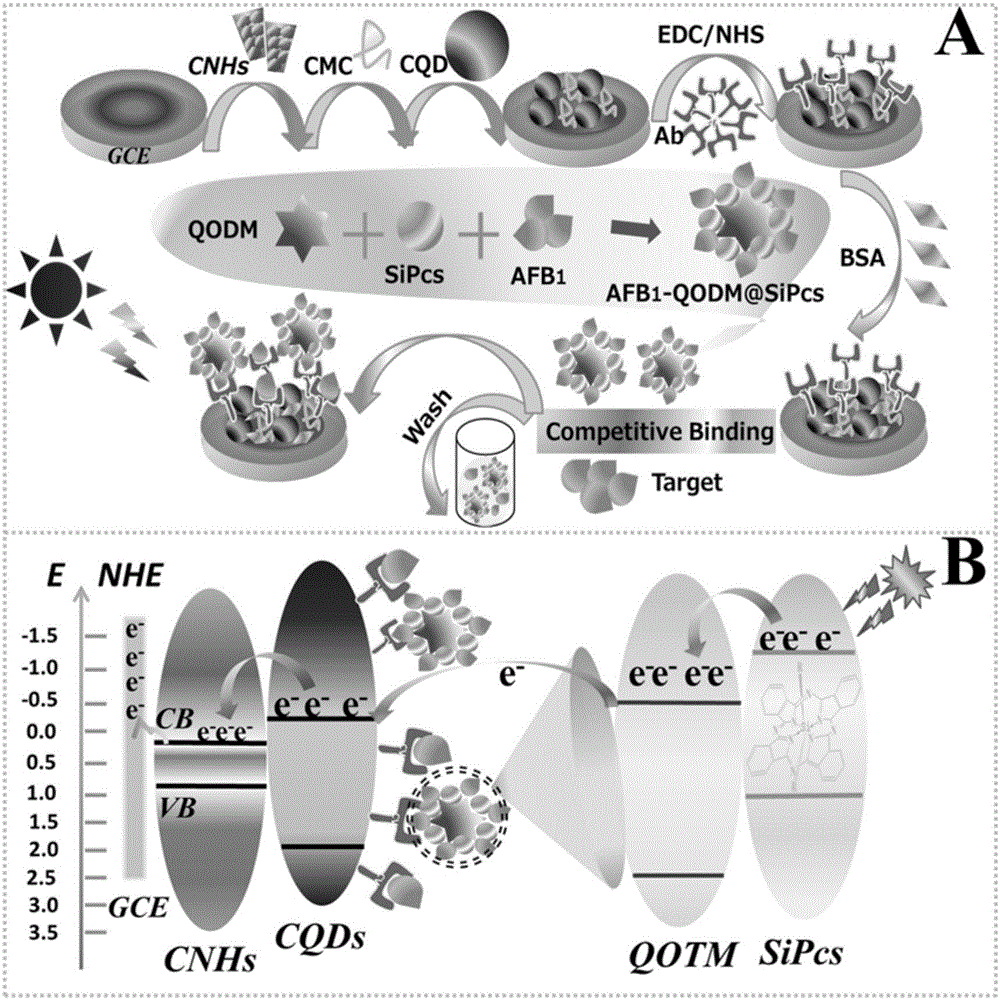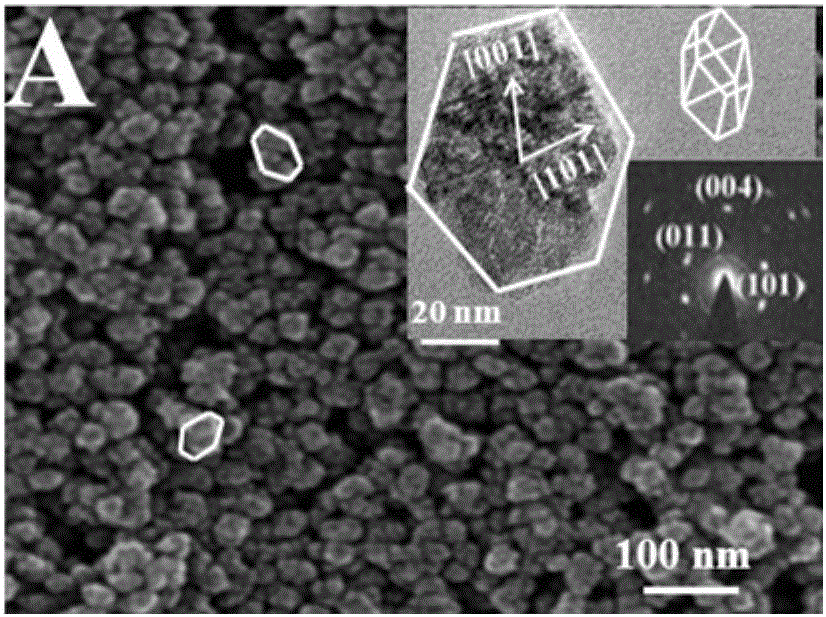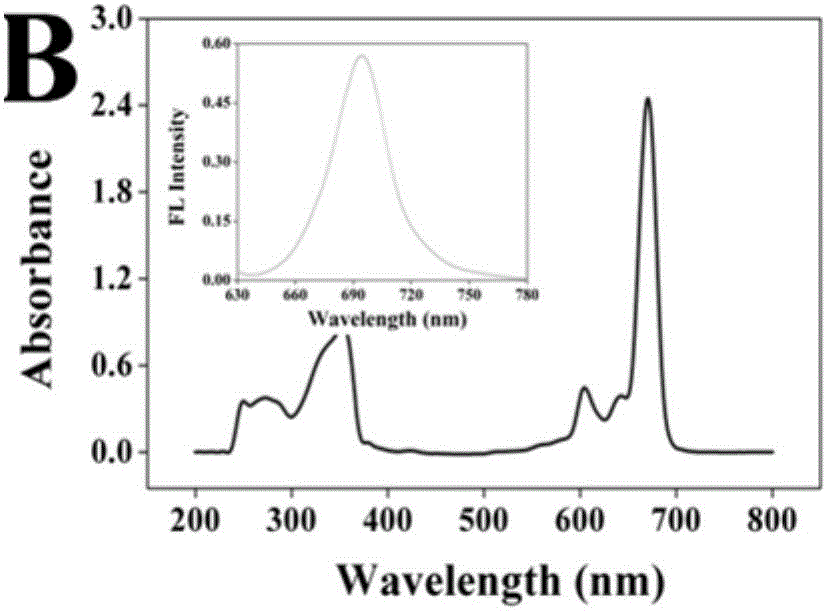Silicon phthalocyanine functionalized TiO2 mesocrystal based aflatoxin photoelectrochemical detection method
An aflatoxin and photoelectrochemical technology, applied in the direction of material electrochemical variables, can solve the problems of large forbidden band width and low photoelectric conversion efficiency, and achieve increased photocurrent, excellent photocurrent response and stability, and excellent electrical conductivity. Effect
- Summary
- Abstract
- Description
- Claims
- Application Information
AI Technical Summary
Problems solved by technology
Method used
Image
Examples
Embodiment 1
[0031] A functionalized TiO based on silicon phthalocyanine dye 2 The preparation method of the photoelectrochemical detection sensor of mesogen (such as figure 1 shown):
[0032] (1) Pretreatment of the glassy carbon electrode: the glassy carbon electrode is first mechanically polished and polished on the suede covered with alumina powder, washed with secondary water to remove the residual powder on the surface, and then moved into an ultrasonic water bath for cleaning until it is cleaned, and finally Wash thoroughly with ethanol, dilute acid and water;
[0033] (2) Apply 3 μL of carbon nanohorns (CNHs) with a concentration of 3 mg / mL evenly on the surface of a clean glassy carbon electrode, dry under infrared light and cool to room temperature;
[0034] (3) Drop 3 μL of 0.5wt% sodium carboxymethylcellulose (CMC) on the CNHs modified electrode for 40 minutes, modify 3 μL of carbon quantum dots (CQDs) on the modified electrode and test it under infrared light Dry, then cool...
Embodiment 2
[0038] Carbon quantum dots (CQDs) materials are prepared by the following method: first add 1g of 4L-cysteine to a beaker, then transfer the beaker to an electric furnace, heat at 280ºC for 5 minutes, cool the beaker to room temperature, and Add ultrapure water into the beaker and centrifuge at 8000 rpm for 5 minutes to obtain the final product, and collect the supernatant by rotary evaporation. Electron emission scanning electron microscopy (SEM) images of CQDs, as Figure 2C As shown, it can be seen that the average diameter of CQDs is 2–3 nm. Such as Figure 2D Shown is the ultraviolet spectrum of CQDs, indicating that CQDs have a broad absorption peak at 300-600nm; photogenerated electrons and holes are easily recombined, which can effectively improve the sensitivity of PEC biosensors.
Embodiment 3
[0040] Quasi-octahedral TiO functionalized with dendrimer silicon phthalocyanine dyes (SiPcs) 2 Mesoscopic crystal (QOTM@SiPcs) bioprobes were prepared by the following method:
[0041] (1) Preparation of dipentyl carboxylic acid SiPcs: 0.20 g SiPcCl 2 , 0.14 g anhydrous K 2 CO 3 and 0.5 mL of hexanoic acid were placed in 30 ml of toluene solvent and refluxed at 110 ° C for 48 hours; then the reaction mixture was cooled to room temperature and the solvent was evaporated to dryness under reduced pressure, and the liquid product was purified with dichloromethane in a Soxhlet extractor After 24 hours, the extracted substance was recrystallized and rinsed with a mixture of methanol and deionized water with a volume ratio of 1:1, and then redissolved in dichloromethane; Figure 2B As shown, the UV spectrum of SiPcs, the B band is at 355nm, the characteristic peak of the dimer is at 604nm, and the Q band is at 678nm; as Figure 2B As shown in the inset, the fluorescence spectru...
PUM
| Property | Measurement | Unit |
|---|---|---|
| diameter | aaaaa | aaaaa |
Abstract
Description
Claims
Application Information
 Login to View More
Login to View More - R&D
- Intellectual Property
- Life Sciences
- Materials
- Tech Scout
- Unparalleled Data Quality
- Higher Quality Content
- 60% Fewer Hallucinations
Browse by: Latest US Patents, China's latest patents, Technical Efficacy Thesaurus, Application Domain, Technology Topic, Popular Technical Reports.
© 2025 PatSnap. All rights reserved.Legal|Privacy policy|Modern Slavery Act Transparency Statement|Sitemap|About US| Contact US: help@patsnap.com



